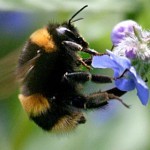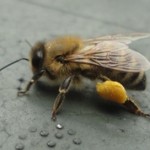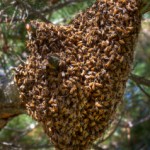More about Bees
There are lots of different types of bee in Britain – around 250 different species, including 25 types of bumblebees, the honey bee and numerous small solitary bee species. However, the most common bees seen in and around most gardens tend to be bumblebees.
Bumblebees
 These are easily recognised as they are usually fat, round and covered in bristly hairs all over their thorax and abdomen. They tend to be predominately black with yellow bands but colours can vary depending on the species. These bees tend to live in small colonies of between 20-200 individuals, usually living near ground level or even under the ground in old mouse nests, although sometimes they will take up resident in empty bird boxes. They are usually harmless and very rarely sting unless severely provoked such as when their nests are disturbed.
These are easily recognised as they are usually fat, round and covered in bristly hairs all over their thorax and abdomen. They tend to be predominately black with yellow bands but colours can vary depending on the species. These bees tend to live in small colonies of between 20-200 individuals, usually living near ground level or even under the ground in old mouse nests, although sometimes they will take up resident in empty bird boxes. They are usually harmless and very rarely sting unless severely provoked such as when their nests are disturbed.
Honey Bees
 These bees are smaller and much less hairy than bumble bees and vary in colour from almost black to alternate bands of dark and light orange. They are usually seen in ones or twos by people in their gardens collecting pollen and nectar from flowers within a 1-2 mile radius of their hive.
These bees are smaller and much less hairy than bumble bees and vary in colour from almost black to alternate bands of dark and light orange. They are usually seen in ones or twos by people in their gardens collecting pollen and nectar from flowers within a 1-2 mile radius of their hive.
Honey bees are only active outside between the months of February and late October. They are generally harmless and are normally very reluctant to sting unless disturbed or if you get close to their hive and they feel threatened as it will result in certain death for the bee.
 Swarms – If you see a large group of honey bees together like this in a tight cluster in late spring or early summer, its probably a swarm – Whilst exciting to look at, they are largely harmless and will stay where they are, sending out scouts to look for a suitable new home. Once they have decided to move to a new location they will leave together in a large cloud of flying bees. Please keep your distance and if causing a nuisance you can call here to arrange for them to be removed by a local beekeeper.
Swarms – If you see a large group of honey bees together like this in a tight cluster in late spring or early summer, its probably a swarm – Whilst exciting to look at, they are largely harmless and will stay where they are, sending out scouts to look for a suitable new home. Once they have decided to move to a new location they will leave together in a large cloud of flying bees. Please keep your distance and if causing a nuisance you can call here to arrange for them to be removed by a local beekeeper.
Providing plants for bees
All Bees need flowers for sustenance, and many flowers need bees for pollination. Many popular flower varieties are hybridised for features that are valued by the gardener, like disease resistance, flower size or colour and bigger, longer blooms. Unfortunately much hybridisation has reduced the production of nectar and pollen and sometimes leaves the resulting plant completely sterile and useless to bees and other pollinators. Another factor is that the amount of nectar secreted is dependent of climate conditions such as temperature, humidity and moisture in the soil. Here is some general advice on what to plant to attract more bees to your garden;
Bees are basically looking for two things when they visit plants:
Nectar – is loaded with carbohydrate in the form of sugars and is bee’s main source of energy.
Pollen – provides the balanced diet of proteins and fats and is particularly required in the Spring as the colony rapidly expands
Both Honey Bees and Bumble Bees are active from late February to September/October, so its a good idea to have at least two nectar- or pollen-rich plants in flower at any one time during this period in your garden. The nectar feeds the adult bee, while the pollen is collected to feed the young. Of course, the more flowers you have, the more attractive your garden is to bees, so you can never have too many!
Native British plants are usually best for native British bees, and can be used in both wild areas and gardens. There are also many garden plants—particularly older varieties of perennials and herbs— especially aromatic species like rosemary, thyme, lavender and others that are good sources of nectar or pollen. Together with native plants, these will make a garden attractive to both pollinators and people
General Gardening Advice for Attracting Bees and Other Pollinators
Don’t use pesticides. Most pesticides are not selective. You are killing off the beneficial insects along with the pests. If you must use a pesticide, start with the least toxic one and follow the label instructions to the letter.
Use local native plants. Research suggests native plants are four times more attractive to native bees than exotic flowers. They are also usually well adapted to your growing conditions and can thrive with minimum attention. In gardens, older varieties of herbs and perennials can also provide good foraging.
Chose several colours of flowers. Bees have good colour vision (albeit shifted towards the ultraviolet end of the spectrum) to help them find flowers and the nectar and pollen they offer. Flower colours that particularly attract bees are blue, purple, violet, white, and yellow.
Plant flowers in clumps. Flowers clustered into clumps of one species will attract more pollinators than individual plants scattered through the habitat patch. Where space allows, make the clumps a metre or more in diameter.
Have a diversity of plants flowering all season. Most bee species are generalists, feeding on a range of plants through their life cycle. By having several plant species flowering at once, and a sequence of plants flowering through summer, autumn and especially early spring you can support a range of bees and other insects species that fly at different times of the year.
Plant where bees will visit. Bees favour sunny spots over shade and need some shelter from strong winds.
Provide a wet area or other source of water. Bees need access to large amounts of water to cool the colony on a hot day and to make beeswax inside the hive particularly in the spring. Place pebbles or a piece of rough cloth at the edge of the water or pond so the bees can alight and drink without falling in and drowning.
Dealing with Bee Stings
When a honey bee stings someone, the sting, venom sac and venom pump are quite often left in the skin after the bee pulls away. Most of the venom will be injected in the first 20 seconds but the pump can continue for up to two minutes. It is therefore important to get the sting out fast to minimise the dose of venom received.
- Pull out or scratch out the sting with a fingernail or credit card as quickly as possible.
- Move some distance away quickly and quietly to reduce the chances of being stung again.
- If you have one, use your smoker heavily on the affected area to mask the alarm pheromones given off by in the sting. Alternatively wash the affected area to mask the scent.
- Apply a soothing lotion, such as Witch Hazel or calamine or an anti-histamine cream onto the affected area.
- Use an ice pack or packet of frozen peas to help to reduce any pain or swelling
- Consider taking a dose of anti-histamine such as Piraton or Benadryl
- IMPORTANT – Severe reactions to bee stings are rare, but if you start feeling faint or develop breathing difficulties after a bee sting call the emergency services immediately.
It’s a sensible idea for beekeepers to keep a small bottle of anti-histamine cream or medicine with their beekeeping tools. Some beekeepers react very little to bee stings and carry on regardless but it is wiser to wear protective clothing and just take the gloves off for delicate work such as queen marking and clipping. This also has the advantage of keeping your hands clean and free from propolis. However, it’s also important to encourage beginners to wear full protective clothing while they gain confidence and find how they react to bee stings.
Some beekeepers like to get stung a few times a year to keep up their ‘immunity’ to stings or to ‘protect’ themselves from rheumatism and arthritis. These points are debatable and must be the personal decision of the beekeeper concerned.
Bee stings can be avoided best by having gentle bees, choosing sensible times and weather to open the hives, by correct use of smoke and gentle handling. Frequent washing of bee suits and gloves will remove any residual sting pheromone and reduce the likelihood of subsequent bee stings. Remember, if stung – get the sting out fast and walk away quickly from the area in case other bees become attracted by the pheromones given off by the stinging bee.
More on honey…
How do bees make honey?
Bees collect nectar from suitable flowers, storing it in a special internal honey sac where it is mixed with certain enzymes before being taken back to the hive where other bees will take the honey and store it inside one of thousands of specially constructed cells that make up a comb. Here the bees monitor the stored nectar, assisting it to lose moisture until it becomes recognisable as honey, consisting of about 83% sugar (mainly fructose and glucose) and about 17% water. When they judge it is “ripe” they will then cap the full cells with a thin layer of white beeswax which keeps the honey in perfect condition for months or even years.
Why do they collect so much?
Bees use a combination of honey (for carbohydrate) and pollen (for protein) as their main food source. It is used to feed both adult bees and the growing brood as they develop within their cells. They bring in large quantities throughout the spring and summer and place into into combs as their food store for the winter, collected so that the colony can live through the winter months when there are few flowers available to forage from. It also gives them a head start on other insects when spring returns. A colony of bees needs a minimum of about 10 kilos of honey to get through the winter, but may actually collect 50 or more kilos of honey in a good year if provided with a suitable hive and protected from pests and diseases by a diligent beekeeper.
It’s this balance between the amount of honey the bees actually collect and store versus what they need for the winter that beekeepers harvest in the summer. We always ensure that the bees are left with enough for the winter and may even feed them if stores get low during a long or hard winter.
What types of honey are there?
Bees will collect nectar from whatever plant or tree is in flower locally at different times of the year, so even if located in the middle of a field of lavender, the hive will also collect nectar from other local plants flowering at different times of the year. So the individual colour, flavour and texture of a particular honey will vary dependant on the nectar being collected. The honey from borage for example is a very light straw colour, whereas bees located in a forest of horse chestnuts and other trees will typically produce a very dark honey almost the colour of Marmite.
All honey starts as liquid nectar and depending on its qualities the honey will gradually form sugar crystals until it becomes almost solid in some cases. The more glucose in the mix the faster this happens, so honey from Oil Seed Rape crystallises fast and honey from Heather has a jelly-like consistency that solidifies very slowly.
My honey has turned solid – is it OK?
Yes. Honey is a unique foodstuff in that it almost never goes off – In fact honey found in Egyptian tombs has been found to be perfectly harmless after being in storage for several thousand years! The “Best Before”date on the label is there because the law requires it on all food, not because honey goes off. Most honey is given a date 2 years after it is bottled, but it might as well be 10 years. However, it will gradually solidify over time, so return it back to its original liquid state, simply take the lid off and warm it. Put the jar either in a pan of hot water or for a minute or less in the microwave and it will re-liquify. NOTE: Never heat honey about 40C otherwise it will destroy the sugars and enzymes that give honey its unique qualities.
Is honey useful to cure hay fever or asthma?
Probably not. Bees collect nectar and pollen from flowering plants and most people are allergic to grasses which the bees usually leave alone. But it’s not a bad thing to try – you might enjoy the honey anyway!
Honey has been found to have extremely useful anti-bacterial properties which is why it has been used as a wound and particularly burn dressing for centuries. It also works well with a little warm milk as a gentle sedative and helps aid sleep, particularly in children, although honey should never be given to children under one year of age.
